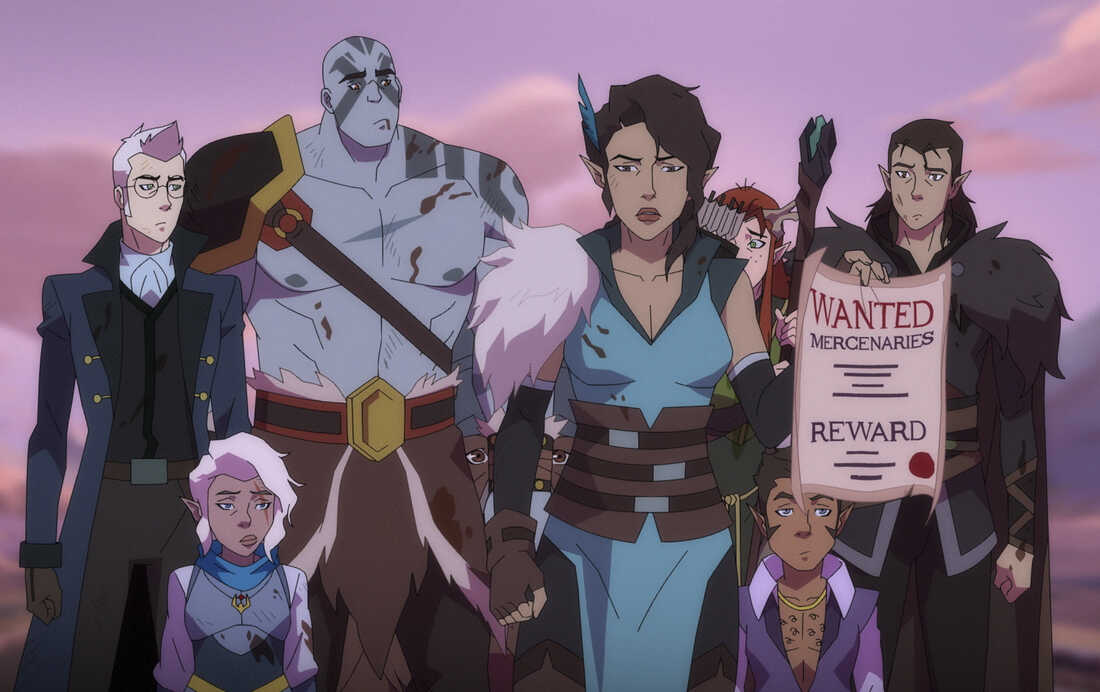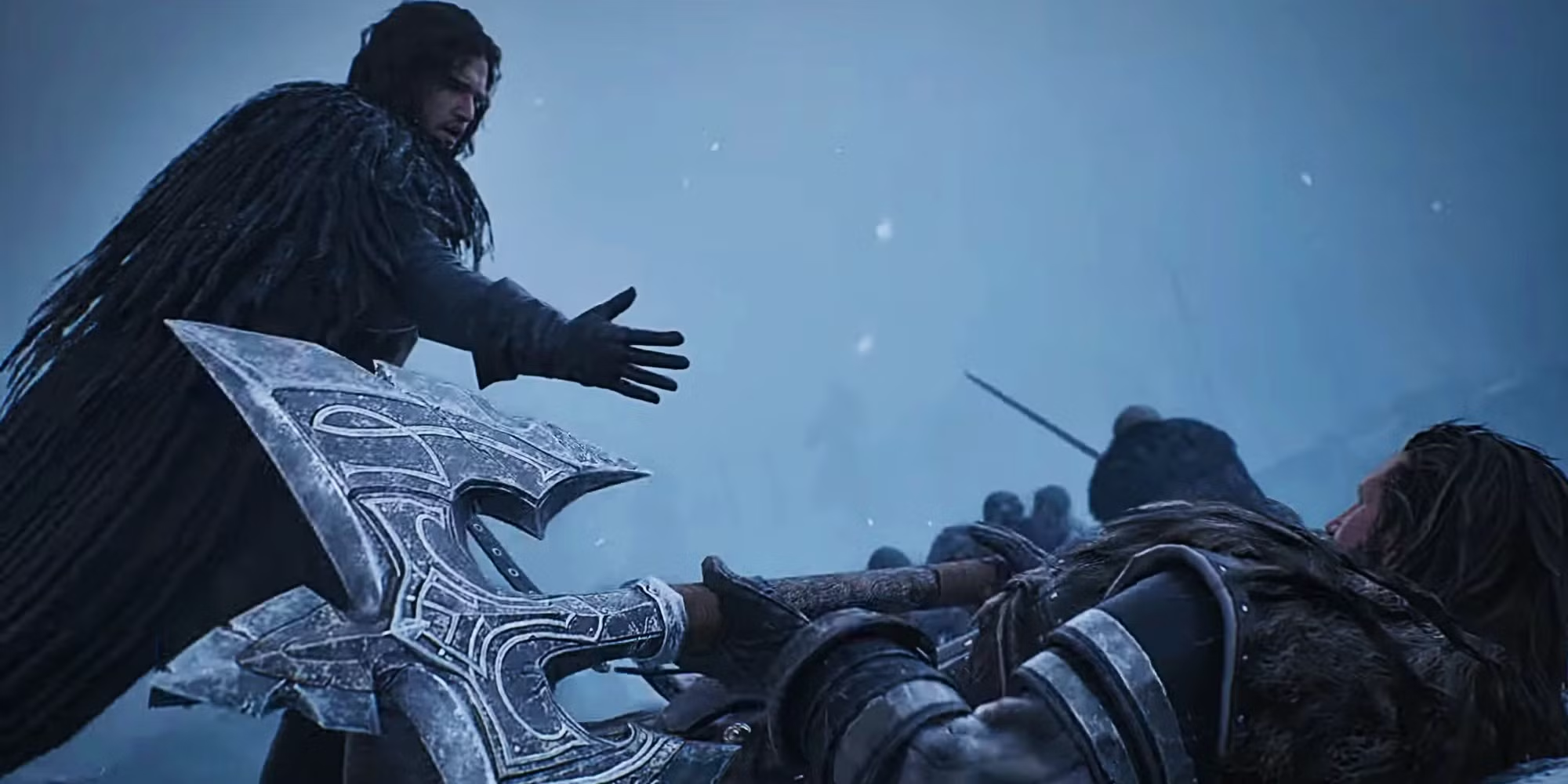
Percy (Taliesin Jaffe), Pike (Ashley Johnson), Grog (Travis Willingham), Vex (Laura Bailey), Keyleth (Marisha Ray) Scanlan (Sam Riegel) and Vax (Liam O’Brien) have +2 swords, will travel.
Amazon Studios
hide caption
toggle caption
Amazon Studios

Percy (Taliesin Jaffe), Pike (Ashley Johnson), Grog (Travis Willingham), Vex (Laura Bailey), Keyleth (Marisha Ray) Scanlan (Sam Riegel) and Vax (Liam O’Brien) have +2 swords, will travel.
Amazon Studios
Fantasy television series have grown thick on the ground — Game of Thrones, The Witcher, His Dark Materials, Shadow and Bone — and there’s more on the way: the Game of Thrones prequel series House of the Dragon later this year, and the Lord of the Rings prequel The Rings of Power, this September.
It’s getting so you can’t swing a dead elf without hitting an orc, or a Darkling, or a Trolloc.
Note: The Legend of Vox Machina premieres on Amazon Prime on Friday, January 28th.
All of these series are adaptations from other forms of media thick with lore, dense with history and heavy with elaborate worldbuilding. The process of adapting works so rich with detail and backstory into compelling episodic television is, of necessity, an exercise in winnowing, distilling and, in some cases, mercilessly hacking and slashing. Characters whom fans adore get roughly combined or disappear completely. Established, intricately overlapping chronologies get cruelly bent to the will of clear, easy-to-follow story arcs. Beloved subplots vanish in puffs of network notes. The implacable schedule of television production is a cruel, unforgiving master, and it jettisons everything it thinks it can get away with.
Fans of the source material inevitably grouse about the elements that get lost in the shuffle, because that’s what fans do. But they’ve got a point: Television adaptations must prioritize plot over established, painstakingly wrought characterization, interiority and even geography. (The characters on Game of Thrones, for example, crossed vast oceans and endless deserts like they were hopping in a cab from the East Village to Hell’s Kitchen.) Which is unfortunate, because of course it’s exactly those layers of historical detail that fundamentally shape the world in question, and its inhabitants.
Amazon’s funny, violent and well-realized The Legend of Vox Machina, based on the popular web series Critical Role, is no different — a lot of things gets lost in translation. But the nature of what’s been tossed over the side is wholly different in nature; as a result, anyone unfamiliar with the source material won’t notice what they’re missing.
It’s not that fact that The Legend of Vox Machina is an animated series that sets it apart from the other fantasy shows listed above. If anything, that only helps it bring the source material to life, as the special effects budget of animation is effectively unlimited — no iffy CGI dragons, rubber costumes or one-dimensional greenscreen vistas here.
No, what distinguishes it is the unique nature of the source material, and the fact that a gorgeous, discursive, shambling mound of a web series has been turned into a show so efficiently, cleanly effective at the comparatively narrow goal it sets out to accomplish.
Organic chemistry 101
Full disclosure: I’ve spent the pandemic stumbling upon, delighting in, and proceeding to devour hundreds and hundreds of episodes of the web series Critical Role. It’s one of several series out there that simply consist of groups of players sitting around a table playing Dungeons & Dragons together.
For the uninitiated: In Dungeons & Dragons, players work with a Dungeon Master — a kind of all-knowing storyteller/referee — to craft storylines about the characters they’re playing, which are called campaigns. The Legend of Vox Machina is based on one of the campaigns that took place on the web series Critical Role.
If you’re scoring at home, we’re talking several weeks’ worth of content, here, as individual Critical Role episodes tend to run three to four hours in length, and the two previous storylines (or campaigns) have run to 115 episodes and 141 episodes respectively. (A third campaign recently launched, plus there’ve been a huge number of one-shots and standalone miniseries, so: Yeah.)
In any given campaign, the same group of players (with some roster changes) play as the same set of characters, while dungeon master Matthew Mercer walks them through the vast world he’s so painstakingly wrought. In the first campaign, which The Legend of Vox Machina is based upon, the characters consist of: Grog, a huge, lovable, but defiantly slow-on-the-uptake barbarian, played by Travis Willingham; Percy, an arrogant gunslinger, played by Taliesin Jaffe; Vex, a charismatic archer, played by Laura Bailey; her twin Vax, a brooding rogue, played by Liam O’Brien; Keyleth, a naive druid, played by Marisha Ray; Scanlan, a horny bard, played by Sam Riegel; and Pike, a compassionate healer, played by Ashley Johnson.
Together, they have adventures, and ultimately, they save the world. But in a very real sense, that’s not what Critical Role is about.
Because each episode of the web series is an individual Dungeons & Dragons game session, it’s … kind of a mess. A palpable, loving, gorgeous mess, filled with in-jokes and dead-ends and call-backs and lulls and pee-breaks and endless rules discussions and running gags and merciless teasing and long waits for players to decide what actions, if any, they’ll take.
Dungeon Master Mercer isn’t to be blamed for this rich, funky, organic messiness; in fact, he’s to be commended for it. He’s a smart enough DM to do all the work necessary to build a vast world for his players to live and fight and die in, but he knows how to channel their energy and let the chemistry between them drive the story wherever it wants to go.
I’ll be honest: A large part of the appeal of Critical Role to me, at a time when all human interaction takes place over interminable Zooms, was and remains watching these friends gathered in the same room, building something together. Howling with collective delight when a dice roll goes their way, howling with collective despair when it doesn’t. Cracking jokes based on their easy, practiced familiarity with one another. Taking impulsive actions that gleefully derail long-laid plans (and, sometimes, the entire game session).
Precisely what they’re building together? The actual story they’re telling, in which their characters combat monsters and embrace and/or reject revenge, find redemption or don’t? It’s interesting enough, sure — but it all takes a back seat to what’s happening in that room, among those players, as they find their way through Mercer’s fascinating world — haltingly, perhaps, but satisfyingly.
Think of it this way: If you love baseball, the final score of a given game is important to you, but it’s not really why you watch.
(I should note that I’m likely an outlier here. To many fans of Critical Role, it’s the story and, specifically, its various characters, who centrally fascinate and delight, as evidenced by the staggering amount of fan art and cosplay that has accreted around the show.)
A narrow slice, but a good one
What’s missing from The Legend of Vox Machina, then, is that room, that energy, that messiness, that sense of organic, ad-hoc, in-the-moment, collaborative creation. Any session of Dungeons & Dragons, after all, is part script (the setting, the rules), and part improv (the players, the dice rolls).
What we get in The Legend of Vox Machina is what’s left over, after all of that chaos energy has been distilled into pure story. Distilled, and greatly condensed: Storylines that stretched over hours and hours on the web series play out, here, over the course of one or two half-hour episodes.
In the five episodes made available to press, the sprawling world Mercer’s built doesn’t get a chance to convey even a hint of its depth, but I suppose it would seem odd if it did, given the narrow remit of the animated series. Here, the team of familiar characters fight many of the same foes they did in the Critical Role campaign, and harbor many of the same secrets.
But does The Legend of Vox Machina stand on its own, if you have no familiarity whatsoever with its source material? Sure.
The animation itself is perfectly serviceable, and will draw inevitable comparisons to other streaming animated fantasy series like The Dragon Prince, The Blood of Zeus and Masters of the Universe: Revelation. Some action sequences tend to go on a beat or two longer than seems strictly necessary, but the same can be said for most Dungeons & Dragons combat sessions.
The voice acting, of course, is beyond reproach, as the Critical Role players (who were all established, professional voice actors before the web series launched) voice the characters they created. In a nice touch, Mercer gets to voice several incidental characters the team runs into, in much the same as he populates Critical Role sessions with a litany of NPCs (non-player characters).
Some might quibble with Riegel’s bawdy bard Scanlan, whose sex-obsessed schtick hits different, if you can’t see the playful, ironic twinkle in the actor’s eye, the way you can on Critical Role.
Mostly, the voice actors manage to invest their line readings with shadings of meaning that will, to the uninitiated, suggest where these characters are headed.
The Legend of Vox Machina is unlikely to attract an audience that isn’t favorably inclined toward the well-established fantasy trope of a boozing, brawling gang of misfit mercenaries. But the script’s got solid jokes, the characters are given room to breathe, and the guest voice cast includes ringers like David Tennant, Tony Hale, Stephanie Beatriz and Gina Torres.
No, the animated series can’t be everything the web series is, but then, it’s aiming for a wider audience. And at that respect at least, its certainly got everything it needs to hit its target.




















![[Book Review] The Blade Itself (The First Law Trilogy) by Joe Abercrombie](https://bendthekneegot.com/wp-content/uploads/2018/01/1516047103_maxresdefault-218x150.jpg)




















